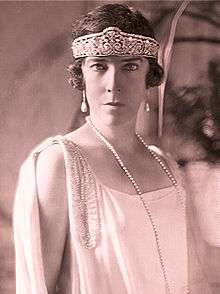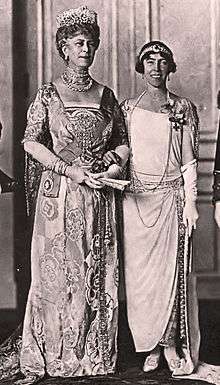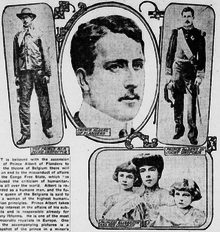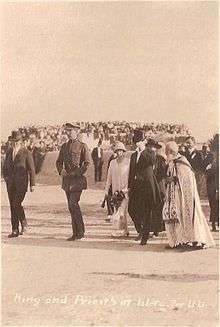Elisabeth of Bavaria, Queen of Belgium
| Elisabeth of Bavaria | |||||
|---|---|---|---|---|---|
 The Queen in 1920. | |||||
| Queen consort of the Belgians | |||||
| Tenure | 17 December 1909 – 17 February 1934 | ||||
| Born |
25 July 1876 Possenhofen Castle, Bavaria | ||||
| Died |
23 November 1965 (aged 89) Brussels, Belgium | ||||
| Burial | Church of Our Lady of Laeken | ||||
| Spouse |
Albert I, King of the Belgians (m. 1900; d. 1934) | ||||
| Issue |
Leopold III, King of the Belgians Prince Charles, Count of Flanders Maria José, Queen of Italy | ||||
| |||||
| House | Wittelsbach | ||||
| Father | Duke Karl-Theodor in Bavaria | ||||
| Mother | Infanta Maria Josepha of Portugal | ||||
| Religion | Roman Catholicism | ||||
Elisabeth of Bavaria (born Elisabeth Gabriele Valérie Marie, Duchess in Bavaria) (25 July 1876 – 23 November 1965) was Queen consort of the Belgians as the spouse of King Albert I, and a Duchess in Bavaria by birth. She was the mother of King Leopold III of Belgium and of Queen Marie José of Italy, and grandmother of kings Baudouin and Albert II of Belgium.
Family
Born in Possenhofen Castle, her father was Karl-Theodor, Duke in Bavaria, head of a cadet branch of the Bavarian royal family, and an ophthalmologist of recognized reputation. She was named in honor of her father's sister, Empress Elisabeth of Austria, better known as Sisi. Her mother was Maria Josepha of Portugal, daughter of exiled Miguel I of Portugal.
An artist himself, Duke Karl-Theodor cultivated the artistic tastes of his family and Elisabeth was raised with a deep love for painting, music and sculpture. At her father's clinic, where her mother assisted her father as a nurse, Elisabeth obtained exposure to productive labour and to human suffering unusual at that time for a princess.
Married life



In Munich on 2 October 1900, Duchess Elisabeth married Prince Albert, second-in-line to the throne of Belgium (after his father Prince Philippe, Count of Flanders). Upon her husband's accession to the Belgian throne in 1909, Elisabeth became queen. The city of Élisabethville, today Lubumbashi, in the Congo was named in her honour.
At the time that Albert and Elisabeth met, Prince Albert was the heir to his uncle Leopold II of the Belgians. Albert was the second son of Prince Philippe, Count of Flanders and Princess Marie of Hohenzollern-Sigmaringen, a sister of King Carol I of Romania.
At birth, Albert occupied the third place in the line of succession behind his father and elder brother, Prince Baudouin. The unexpected death of Baudouin in January 1891 immediately raised Albert to prominence within his country. A studious, quiet man, Albert was not the choice of heir that King Leopold II would have relished. As the only living male member of his generation, Albert was guaranteed the Crown of the Belgians upon the King's death. Albert had two sisters who survived into adulthood, Princess Henriette who married Prince Emmanuel of Orléans, and Princess Josephine who married her cousin, Prince Karl-Anton of Hohenzollern-Sigmaringen, brother of King Ferdinand I of Romania.
During the First World War, she and the King resided in De Panne. The Queen made herself beloved by visiting the front lines and by sponsoring a nursing unit. Despite her German background, she was a popular queen, perceived as eagerly supporting her adoptive country.
From September 23 till November 13, 1919, the Queen, together with the King and Prince Léopold, undertook an official visit to the United States of America. During a journey in the historic pueblo of Isleta in New Mexico, the King awarded the Order of Léopold to Father Anton Docher.[1] As a memento, the King was given a turquoise cross mounted in silver made by the Tiwa people.[2] Ten thousand people traveled to Isleta for the occasion.

Later years
In 1934, Albert I died in a climbing accident in the Ardennes of Belgium, near Namur. Elisabeth lived to see her son become king (but also go into exile and abdicate), her younger son become, effectively, regent of the realm, and her grandson mount the throne.
As queen dowager, she became a patron of the arts and was known for her friendship with such notable scientists as Albert Einstein. During the German occupation of Belgium from 1940 to 1944, she used her influence as queen and German connections to assist in the rescue of hundreds of Jewish children from deportation by the Nazis.[3] When Brussels was liberated, she allowed her palace to be used for headquarters of the British XXX Corps, and presented its commander General Horrocks with its mascot, a young wild boar named 'Chewing Gum'.[4] After the war she was awarded the title Righteous Among the Nations by the Israeli government.
During the 1950s, the Queen evoked controversy abroad by visiting the Soviet Union, China and Poland, trips that prompted some to label her as the "Red Queen ."
Queen Elisabeth died in Brussels at the age of 89 on 23 November 1965 from a heart attack. She is interred in the royal vault at the Church of Our Lady of Laeken, Brussels. She was the 1,016th Dame of the Royal Order of Queen Maria Luisa.
Children
- Léopold Philippe Charles Albert Meinrad Hubertus Marie Miguel, Duke of Brabant, Prince of Belgium, who became later the fourth king of the Belgians (as Leopold III), born 3 November 1901, and died at Woluwe-Saint-Lambert on 25 September 1983.
- Charles-Théodore Henri Antoine Meinrad, Count of Flanders, Prince of Belgium, Regent of Belgium, born Brussels 10 October 1903, and died at Ostend on 1 June 1983.
- Marie-José Charlotte Sophie Amélie Henriette Gabrielle, Princess of Belgium, born Ostend 4 August 1906. She was married at Rome, Italy, on 8 January 1930 to Prince Umberto Nicola Tommaso Giovanni Maria, Prince of Piedmont, born on 15 September 1904, and died on 18 March 1983, at Geneva, Switzerland. He became King Umberto II of Italy on 9 May 1946. Marie-José died 27 January 2001.
Arms
 |
 |
Titles, styles and honours
Titles
- 25 July 1876 – 2 October 1900: Her Royal Highness Duchess Elisabeth in Bavaria
- 2 October 1900 – 17 December 1909: Her Royal Highness Princess Albert of Belgium, Princess of Saxe-Coburg and Gotha, Duchess in Saxony
- 17 December 1909 – 17 February 1934: Her Majesty The Queen of the Belgians
- 17 February 1934 – 23 November 1965: Her Majesty Queen Elisabeth of Belgium
Honours
National honours
-
.svg.png) House of Wittelsbach: Dame of the Order of Saint Elizabeth
House of Wittelsbach: Dame of the Order of Saint Elizabeth -
.svg.png) Belgium: Knight Grand Cross of the Order of Leopold[5]
Belgium: Knight Grand Cross of the Order of Leopold[5]
Foreign honours
-
 France: Grand Cross of the Order of the Legion of Honour[6][7][8]
France: Grand Cross of the Order of the Legion of Honour[6][7][8] -
 Italy
Italy
-
 Vatican
Vatican
-
 Holy See: Dame of the Decoration of Honour[9]
Holy See: Dame of the Decoration of Honour[9]
-
-
-
 Japan: Paulownia Dame Grand Cordon of the Order of the Precious Crown[10]
Japan: Paulownia Dame Grand Cordon of the Order of the Precious Crown[10] -
 Luxembourg: Dame Grand Cross of the Order of the Gold Lion of the House of Nassau[11]
Luxembourg: Dame Grand Cross of the Order of the Gold Lion of the House of Nassau[11] -
 Netherlands: Dame Grand Cross of the Order of the Netherlands Lion[12][13]
Netherlands: Dame Grand Cross of the Order of the Netherlands Lion[12][13] -
 Netherlands: Recipient of the Queen Juliana Inauguration Medal
Netherlands: Recipient of the Queen Juliana Inauguration Medal -
 Poland: Grand Cross of the Order of the White Eagle[14]
Poland: Grand Cross of the Order of the White Eagle[14] -
 Poland: Recipient of the Cross of Valour Medal[15]
Poland: Recipient of the Cross of Valour Medal[15] -
 Romanian Royal Family: Honorary Dame Grand Cross of the Royal Order of Carol I[16]
Romanian Royal Family: Honorary Dame Grand Cross of the Royal Order of Carol I[16] -
.svg.png) Spanish Royal Family: 1, 016th Dame Grand Cross of the Royal Order of Queen Maria Luisa[17][18]
Spanish Royal Family: 1, 016th Dame Grand Cross of the Royal Order of Queen Maria Luisa[17][18] -
 United Kingdom: Member of the Decoration of the Royal Red Cross[19][20][21]
United Kingdom: Member of the Decoration of the Royal Red Cross[19][20][21]
Ancestry
See also
References
- ↑ Keleher and Chant. The Padre of Isleta. Sunstone Press, 2009, p. 94.
- ↑ W.A.Keleher.The Indian sentinel.1920,vol.2. p.23-24
- ↑ Élisabeth en Bavière - her activity to save Jews' lives during the Holocaust, at Yad Vashem website
- ↑ p.70, Horrocks, Brian, Belfield, Eversley, Essame, H., Corps Commader, Magnum Books, London, 1977
- ↑ http://neon.pictura-hosting.nl/sfa/sfa_mrx_bld/thumbs/500x500/upload/upload_799/SFA022821501.jpg
- ↑ https://commons.wikimedia.org/wiki/File:QueenElisabethLegionOfHonour.jpg
- ↑ http://1914-18.be/wp-content/uploads/2014/08/site-to-Liège-juillet-19-légion-dhonneur-poincaré-reine-roi.jpg
- ↑ http://www.liege.be/vie-communale/la-legion-dhonneur
- ↑ https://upload.wikimedia.org/wikipedia/commons/7/71/King_Albert_I%2C_and_Queen_Elisabeth_of_Belgium_-Pontificale_Audiëntie.jpg
- ↑ http://2.bp.blogspot.com/-btHvtbHXL9I/VW62nmc6BWI/AAAAAAAAL_U/9w6-Z93_lK4/s1600/eli4001.jpg
- ↑ "Grand Duchess Charlotte of Luxemburg".
- ↑ https://commons.wikimedia.org/wiki/File:QueensJulianaAndElisabeth.jpg
- ↑ Inauguration of Queen Juliana
- ↑ Kawalerowie i statuty Orderu Orła Białego 1705-2008, 2008, s. 300
- ↑ Dziennik Personalny M.S.Wojsk. Nr 13 z 8.06.1922 r.
- ↑ "Flickr".
- ↑ https://s-media-cache-ak0.pinimg.com/736x/6d/c7/2b/6dc72b7a5778c3eec17eae93ef190054.jpg
- ↑ http://farm3.static.flickr.com/2426/3952194445_8f15d7c23c.jpg
- ↑ https://c4.staticflickr.com/4/3370/3237909527_8b5fefbc35.jpg
- ↑ https://c1.staticflickr.com/5/4042/4281479070_94c7137909_z.jpg?zz=1
- ↑ Queen Mary and Queen Elisabeth
External links
![]() Media related to Elisabeth of Bavaria, Queen of Belgium at Wikimedia Commons
Media related to Elisabeth of Bavaria, Queen of Belgium at Wikimedia Commons
| Elisabeth of Bavaria, Queen of Belgium Born: 25 July 1876 Died: 23 November 1965 | ||
| Belgian royalty | ||
|---|---|---|
| Vacant Title last held by Marie Henriette of Austria |
Queen consort of the Belgians 1909–1934 |
Succeeded by Astrid of Sweden |